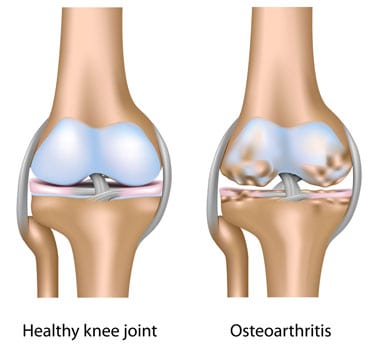Why is my Arthritis Worse on One Side? (Three Reasons)
As we age, the normal wear and tear of daily living begins to take its toll. The wear and tear process contributes to degenerative changes in our joints, also known as osteoarthritis (OA). Osteoarthritis is a process which wears away the cartilage (or cushion) of a joint. The thinning of this “cushion” exposes bone, which is why you’ve likely heard someone say that their knee is “bone on bone.”
The wearing of our joints is often thought of as a inevitable aging process; however, if age is to blame wouldn’t everyone have arthritis? Why does arthritis only occur to certain joints and not others? How are individuals in their 70’s or older not experiencing arthritis in their joints, while some in their 30’s are?
While OA can affect any joint in the body, the knee is most commonly targeted. In fact, knee OA affects nearly one in two women and one in three men (1). As our joint cushions break down (cartilage and meniscus), friction, inflammation, and pain can occur as the bones rub together. Hence the phrase “bone on bone.”

It’s easy to blame age; however, genetics and increased body weight are the two leading predictors of arthritis (1). One factor you have control over, while the other is left to your family tree. While the research points to genetics and body weight as primary risk factors for arthritis, it still doesn’t explain why most of the population experiences osteoarthritis predominantly on one side.
If weight and genetics are the only factors, both joints should wear down equally, right? If you looked at an X-ray of both knees, the degenerative changes are not likely to be identical. Other factors can speed the degenerative process. Here are three reasons you may have a joint with more arthritis than it’s counterpart:
1. Prior Injuries
Remember that old high school injury you shrugged off? Prior injury has been found to be a major source for future OA development (2). A recent study revealed a 3-fold increase in prevalence of OA found in a knee joint after an ACL repair when compared to the opposite (healthy) knee (3). Even if the injury was treated and fully healed it may come back and haunt you years later. This is more reason than ever to never underestimate the value in rehab.
2. Repetitive Movements
Repetitive movements typically relate to occupation. Work that involve repetitive kneeling, squatting, or lifting can lead to OA development. This is especially true if the movement favors one side vs. the other (ie repetitive twisting to the right). Not in a physical job? Years of sitting with one leg crossed over the other can also be potentially alter joint integrity. The act of simply climbing the stairs with the same foot each time increases the force placed on one side of the body.
3. Muscle Imbalance
Tight or weak muscles will cause your joint to deviate from ideal movement patterns. These deviations cause extra stress and may speed degenerative changes. Surprisingly, the gluteal (buttock) muscles provide major support for the knee.
A study by Hinman et al. found that people who suffer from knee OA demonstrated significant unilateral gluteal muscle weakness (4). Weakness of those outer hip muscles will impair the knees ability to react to force, potentially leading to injury or worsening OA. The hamstrings, quadriceps, and calf muscles also provide support around the knee.
Now that you can’t blame the number of candles on your cake for knee OA, you can take measures to save your joints. A well planned exercise program can reduce the effects of OA on your knee joint and even minimize your risk for surgery. If a gym workout is too intense for the current condition of your knee, try aquatic therapy. Aquatic therapy decreases the pressure on your knee while allowing for muscle strengthening and pain free motion.
If you are dealing with pain from arthritis and would like to consult a physical therapist, click the link below to schedule your free discovery visit at Buffalo Rehab Group.
References
- Dillon, Charles F., et al. “Prevalence of knee osteoarthritis in the United States: arthritis data from the Third National Health and Nutrition Examination Survey 1991-94.” The Journal of rheumatology 33.11 (2006): 2271-2279.
- Bhatia, Dinesh, Tatiana Bejarano, and Mario Novo. “Current interventions in the management of knee osteoarthritis.” Journal of pharmacy & bioallied sciences 5.1 (2013): 30.
- Barenius, Björn, et al. “Increased risk of osteoarthritis after anterior cruciate ligament reconstruction a 14-year follow-up study of a randomized controlled trial.” The American journal of sports medicine 42.5 (2014): 1049-1057.
- Hinman, Rana S., et al. “Hip muscle weakness in individuals with medial knee osteoarthritis.” Arthritis care & research 62.8 (2010): 1190-1193.
Want to feel and move your best?
Treatment is covered by insurance, no referral is needed to start, and with flexible virtual and in-clinic appointments available, you can find a time that works with your schedule.
Click the button below to get started.
